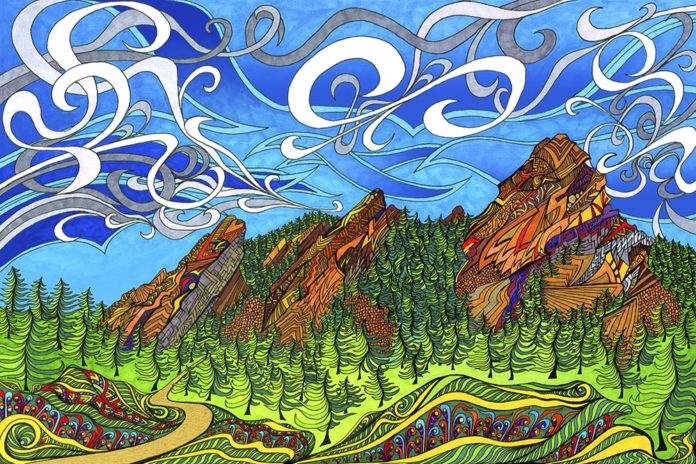Behind the Desk… is an ongoing series that profiles people influencing and advancing the industry in gyms across the country. This month, CBJ chats behind the desk with artist Phil Lewis, who paints elaborate patterns and illustrations on climbing walls as part of a collaboration with Eldorado Climbing. Lewis’ colorful wall panels measure 42’’ x 42’’ and feature t-nuts, ready to be installed in any gym. Could Lewis and a few other professional artists be leading the way toward a new industry trend of high-quality artist/wall company collaborations? CBJ wanted to get Lewis’ thoughts and find out.
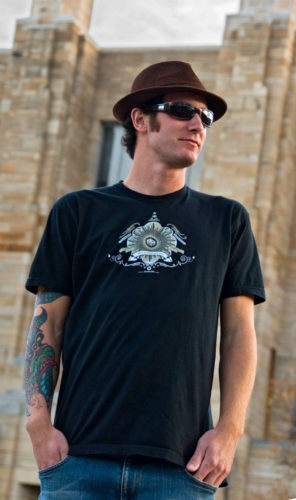
Name: Phil Lewis
Title: Artist/Collaborator with Eldorado Climbing Walls
Location: Boulder, Colorado
Instagram: @phillewisart
CBJ: I suppose a good starting question would be: Do you have a climbing background?
Lewis: I don’t really have a climbing background, but I do have a serious love for nature. I grew up on the north shore of Lake Tahoe…hiking, biking, snowboarding, wakeboarding, scrambling the massive boulders along the shoreline, etc. Spending my formative years in such a pristine mountain environment really taught me the value of being outdoors, and these themes have carried through into my artwork all these years later. It’s also why I love living in Boulder so much. There is a shared love for physical activity, both outdoors and in, that most folks who live here appreciate. There are hundreds of miles of trails right out the backdoor; it’s an incredible place to be.
CBJ: So how did you connect with Eldorado Climbing for the climbing wall panel collaboration?
Lewis: It was through the intertwined communities of yoga, climbing, art, music and overall joy for life that we found each other. Boulder County is home to many entrepreneurs, and there are many people feeling similar flows. We are all building things that we are truly passionate about. When Mike Wedding [Senior Director of Sales at Eldorado Climbing] reached out to me about combining my artwork with their custom panels, it felt like an incredible opportunity to create something special together.
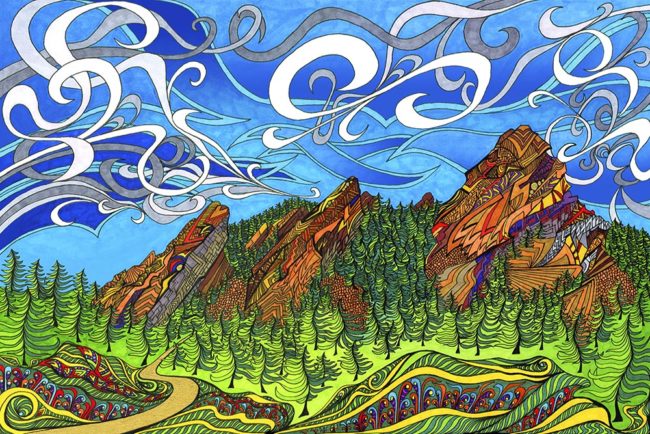
CBJ: Tell me a little about the process of painting the climbing wall panels. How do you decide what to paint, and what’s the timeline?
Lewis: For this project we chose pieces from my catalog that feature the local geography. Using the Flatirons felt unbelievably appropriate. There are many climbing routes all over these rock formations in real life, and I thought it would be a cool idea to climb up the rock faces depicted in the artwork on the panel itself. Another piece, Red Rocks, features a world-famous local amphitheater in Colorado comprised almost entirely of rocks. It also felt like a great fit for these climbing wall panels. Arise is a compilation of many of my pieces from the past few years that were put together to create a totem of different animals. The title of the piece itself felt like a great match, to literally arise up the face of the panel as you climb.
Two of the other pieces, Frequency and Remix, were a little more abstract…we wanted to go with something that was fully symmetrical, so you could combine as many panels together as you wanted to create a seamless installation. I also wanted to focus on color schemes that embodied rocks. The designs themselves are pretty psychedelic and captivating. I thought it would be fun to get lost in these images as you’re making your way up the wall. I feel like they could provide more of a freestyle route, just flowing with the image in less of a particular direction.
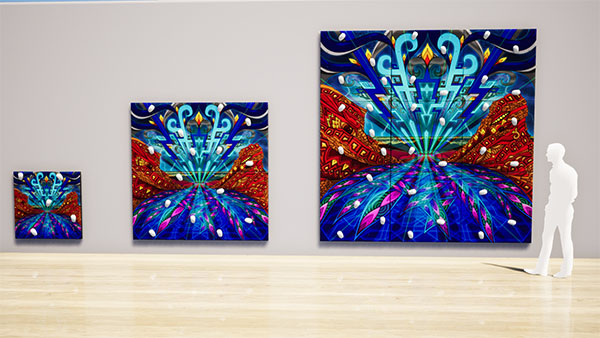
CBJ: I think gym climbing walls are a unique canvas, in that people are physically interacting with the art. Does this influence what you paint on the panels?
Lewis: Creating art and art-products that people can interact with has been a major focus of mine over the course of my career so far. At the core, I still love to make big art pieces for a wall at your home or office, but there’s so many other applications that can have a much wider reach.
I make all kinds of things like puzzles, coloring books, golf discs, hats, yoga mats, apparel, phone cases, engraved water bottles, stickers…the list really goes on and on. When you have art on something that you can carry with you, or wear, it has a way of enhancing your daily life. The people you interact with get a chance to see your choices for expression, even as you simply walk down the street. A super-colorful bandana, or psychedelic phone case, can be a conversation starter. It goes beyond simply sharing expression and becomes more engaging when you are physically interacting with the artwork.
For example, my puzzles or coloring books—by putting the pieces together, or coloring in the pages, you are actually participating in creating the artwork. This is what was so attractive to me about the climbing wall project. By having artwork on the panels, people can actually—physically—engage with the line-work and patterns. Climbers can pick a line up different color segments or around certain elements. I think it provides an opportunity to be more creative with the routes; there’s just so much more to work with when the surface is visually dynamic.
However, going back to the beginning, when people are not actually climbing on it, it’s still a giant piece of artwork on the wall! Especially when viewed from a distance, I think these panels will be eye-catching and entice people to get closer to them. I’ve always really appreciated patterns and details, and when you really dive into my work, you can notice more and more within each section. I imagine climbing these, with your face 6 inches from the art, will provide an excellent opportunity to dive deeper into the artwork, and hopefully deeper into the climb.
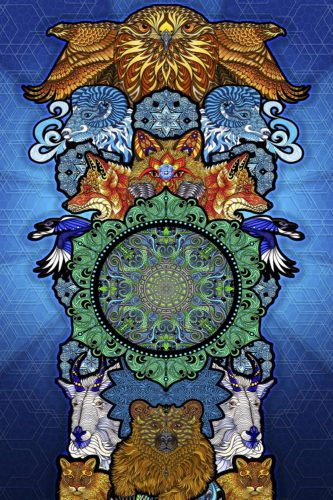
CBJ: Over the years, a lot of gyms have painted their wall panels in various ways. But there are still a lot of gyms that just have plain-colored walls or very basic, utilitarian paint designs. Do you feel like climbing walls are fairly untapped places for artistic expression?
Lewis: Absolutely! I think it’s similar to the rise in popularity of murals in recent years. Many business and property owners are realizing the impact that artwork can have on an establishment. Artwork creates a vibe and sets a tone in a really powerful way. When you see the value of adding artwork to your space, people will recognize that immediately—and notice that conscious choices have been made to enhance the environment. I can totally see the same thing happening with climbing gyms… this is another awesome opportunity for large-scale artwork.
Share your story
Are you leading a climbing gym or brand through this unprecedented period? Or, do you work in the industry and have a story that others could benefit from hearing? If so, please contact us and tell us about it.

John Burgman is the author of High Drama, a book that chronicles the history of American competition climbing. He is a Fulbright journalism grant recipient and a former magazine editor. He holds a master’s degree from New York University and bachelor’s degree from Miami University. In addition to writing, he coaches a youth bouldering team. Follow him on Twitter @John_Burgman and Instagram @jbclimbs. Read our interview Meet John Burgman, U.S. Comp Climbing’s Top Journalist.




